Yuming Li
WristWorld: Generating Wrist-Views via 4D World Models for Robotic Manipulation
Oct 08, 2025Abstract:Wrist-view observations are crucial for VLA models as they capture fine-grained hand-object interactions that directly enhance manipulation performance. Yet large-scale datasets rarely include such recordings, resulting in a substantial gap between abundant anchor views and scarce wrist views. Existing world models cannot bridge this gap, as they require a wrist-view first frame and thus fail to generate wrist-view videos from anchor views alone. Amid this gap, recent visual geometry models such as VGGT emerge with geometric and cross-view priors that make it possible to address extreme viewpoint shifts. Inspired by these insights, we propose WristWorld, the first 4D world model that generates wrist-view videos solely from anchor views. WristWorld operates in two stages: (i) Reconstruction, which extends VGGT and incorporates our Spatial Projection Consistency (SPC) Loss to estimate geometrically consistent wrist-view poses and 4D point clouds; (ii) Generation, which employs our video generation model to synthesize temporally coherent wrist-view videos from the reconstructed perspective. Experiments on Droid, Calvin, and Franka Panda demonstrate state-of-the-art video generation with superior spatial consistency, while also improving VLA performance, raising the average task completion length on Calvin by 3.81% and closing 42.4% of the anchor-wrist view gap.
ThinkLess: A Training-Free Inference-Efficient Method for Reducing Reasoning Redundancy
May 21, 2025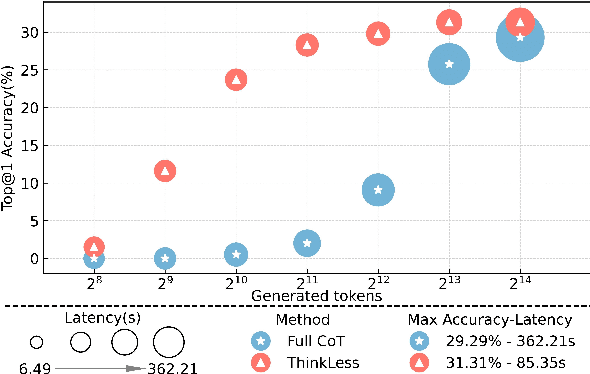

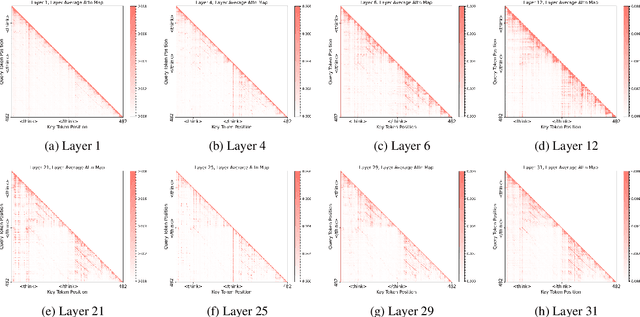
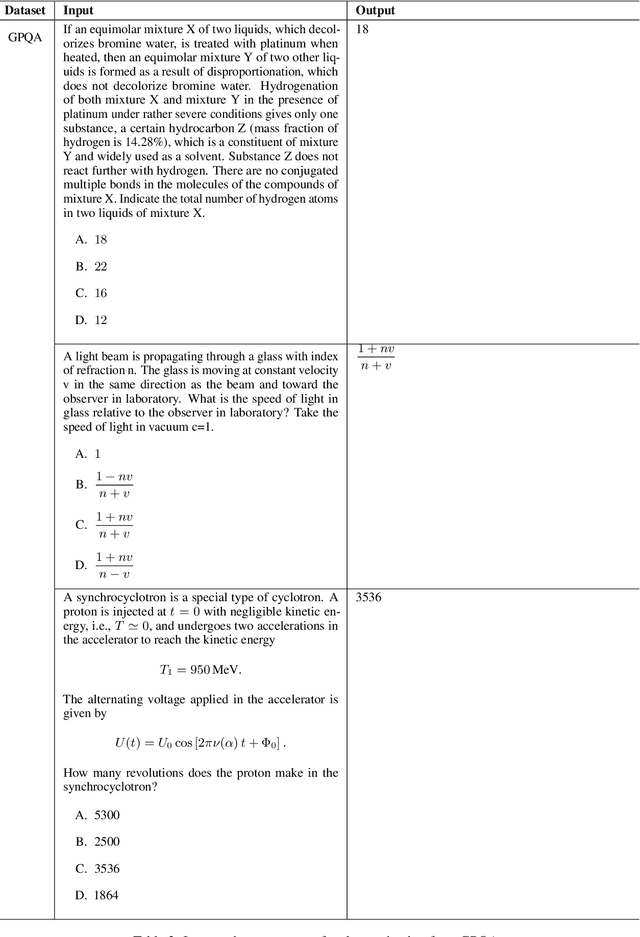
Abstract:While Chain-of-Thought (CoT) prompting improves reasoning in large language models (LLMs), the excessive length of reasoning tokens increases latency and KV cache memory usage, and may even truncate final answers under context limits. We propose ThinkLess, an inference-efficient framework that terminates reasoning generation early and maintains output quality without modifying the model. Atttention analysis reveals that answer tokens focus minimally on earlier reasoning steps and primarily attend to the reasoning terminator token, due to information migration under causal masking. Building on this insight, ThinkLess inserts the terminator token at earlier positions to skip redundant reasoning while preserving the underlying knowledge transfer. To prevent format discruption casued by early termination, ThinkLess employs a lightweight post-regulation mechanism, relying on the model's natural instruction-following ability to produce well-structured answers. Without fine-tuning or auxiliary data, ThinkLess achieves comparable accuracy to full-length CoT decoding while greatly reducing decoding time and memory consumption.
OASIS: Optimized Lightweight Autoencoder System for Distributed In-Sensor computing
May 04, 2025



Abstract:In-sensor computing, which integrates computation directly within the sensor, has emerged as a promising paradigm for machine vision applications such as AR/VR and smart home systems. By processing data on-chip before transmission, it alleviates the bandwidth bottleneck caused by high-resolution, high-frame-rate image transmission, particularly in video applications. We envision a system architecture that integrates a CMOS image sensor (CIS) with a logic chip via advanced packaging, where the logic chip processes early-stage deep neural network (DNN) layers. However, its limited compute and memory make deploying advanced DNNs challenging. A simple solution is to split the model, executing the first part on the logic chip and the rest off-chip. However, modern DNNs require multiple layers before dimensionality reduction, limiting their ability to achieve the primary goal of in-sensor computing: minimizing data bandwidth. To address this, we propose a dual-branch autoencoder-based vision architecture that deploys a lightweight encoder on the logic chip while the task-specific network runs off-chip. The encoder is trained using a triple loss function: (1) task-specific loss to optimize accuracy, (2) entropy loss to enforce compact and compressible representations, and (3) reconstruction loss (mean-square error) to preserve essential visual information. This design enables a four-order-of-magnitude reduction in output activation dimensionality compared to input images, resulting in a $2{-}4.5\times$ decrease in energy consumption, as validated by our hardware-backed semi-analytical energy models. We evaluate our approach on CNN and ViT-based models across applications in smart home and augmented reality domains, achieving state-of-the-art accuracy with energy efficiency of up to 22.7 TOPS/W.
ManipDreamer: Boosting Robotic Manipulation World Model with Action Tree and Visual Guidance
Apr 23, 2025



Abstract:While recent advancements in robotic manipulation video synthesis have shown promise, significant challenges persist in ensuring effective instruction-following and achieving high visual quality. Recent methods, like RoboDreamer, utilize linguistic decomposition to divide instructions into separate lower-level primitives, conditioning the world model on these primitives to achieve compositional instruction-following. However, these separate primitives do not consider the relationships that exist between them. Furthermore, recent methods neglect valuable visual guidance, including depth and semantic guidance, both crucial for enhancing visual quality. This paper introduces ManipDreamer, an advanced world model based on the action tree and visual guidance. To better learn the relationships between instruction primitives, we represent the instruction as the action tree and assign embeddings to tree nodes, each instruction can acquire its embeddings by navigating through the action tree. The instruction embeddings can be used to guide the world model. To enhance visual quality, we combine depth and semantic guidance by introducing a visual guidance adapter compatible with the world model. This visual adapter enhances both the temporal and physical consistency of video generation. Based on the action tree and visual guidance, ManipDreamer significantly boosts the instruction-following ability and visual quality. Comprehensive evaluations on robotic manipulation benchmarks reveal that ManipDreamer achieves large improvements in video quality metrics in both seen and unseen tasks, with PSNR improved from 19.55 to 21.05, SSIM improved from 0.7474 to 0.7982 and reduced Flow Error from 3.506 to 3.201 in unseen tasks, compared to the recent RoboDreamer model. Additionally, our method increases the success rate of robotic manipulation tasks by 2.5% in 6 RLbench tasks on average.
Enhancing Higher Education with Generative AI: A Multimodal Approach for Personalised Learning
Feb 11, 2025



Abstract:This research explores the opportunities of Generative AI (GenAI) in the realm of higher education through the design and development of a multimodal chatbot for an undergraduate course. Leveraging the ChatGPT API for nuanced text-based interactions and Google Bard for advanced image analysis and diagram-to-code conversions, we showcase the potential of GenAI in addressing a broad spectrum of educational queries. Additionally, the chatbot presents a file-based analyser designed for educators, offering deep insights into student feedback via sentiment and emotion analysis, and summarising course evaluations with key metrics. These combinations highlight the crucial role of multimodal conversational AI in enhancing teaching and learning processes, promising significant advancements in educational adaptability, engagement, and feedback analysis. By demonstrating a practical web application, this research underlines the imperative for integrating GenAI technologies to foster more dynamic and responsive educational environments, ultimately contributing to improved educational outcomes and pedagogical strategies.
ASGDiffusion: Parallel High-Resolution Generation with Asynchronous Structure Guidance
Dec 09, 2024Abstract:Training-free high-resolution (HR) image generation has garnered significant attention due to the high costs of training large diffusion models. Most existing methods begin by reconstructing the overall structure and then proceed to refine the local details. Despite their advancements, they still face issues with repetitive patterns in HR image generation. Besides, HR generation with diffusion models incurs significant computational costs. Thus, parallel generation is essential for interactive applications. To solve the above limitations, we introduce a novel method named ASGDiffusion for parallel HR generation with Asynchronous Structure Guidance (ASG) using pre-trained diffusion models. To solve the pattern repetition problem of HR image generation, ASGDiffusion leverages the low-resolution (LR) noise weighted by the attention mask as the structure guidance for the denoising step to ensure semantic consistency. The proposed structure guidance can significantly alleviate the pattern repetition problem. To enable parallel generation, we further propose a parallelism strategy, which calculates the patch noises and structure guidance asynchronously. By leveraging multi-GPU parallel acceleration, we significantly accelerate generation speed and reduce memory usage per GPU. Extensive experiments demonstrate that our method effectively and efficiently addresses common issues like pattern repetition and achieves state-of-the-art HR generation.
Efficient Video Face Enhancement with Enhanced Spatial-Temporal Consistency
Nov 25, 2024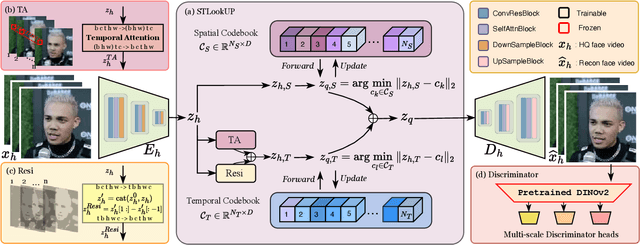



Abstract:As a very common type of video, face videos often appear in movies, talk shows, live broadcasts, and other scenes. Real-world online videos are often plagued by degradations such as blurring and quantization noise, due to the high compression ratio caused by high communication costs and limited transmission bandwidth. These degradations have a particularly serious impact on face videos because the human visual system is highly sensitive to facial details. Despite the significant advancement in video face enhancement, current methods still suffer from $i)$ long processing time and $ii)$ inconsistent spatial-temporal visual effects (e.g., flickering). This study proposes a novel and efficient blind video face enhancement method to overcome the above two challenges, restoring high-quality videos from their compressed low-quality versions with an effective de-flickering mechanism. In particular, the proposed method develops upon a 3D-VQGAN backbone associated with spatial-temporal codebooks recording high-quality portrait features and residual-based temporal information. We develop a two-stage learning framework for the model. In Stage \Rmnum{1}, we learn the model with a regularizer mitigating the codebook collapse problem. In Stage \Rmnum{2}, we learn two transformers to lookup code from the codebooks and further update the encoder of low-quality videos. Experiments conducted on the VFHQ-Test dataset demonstrate that our method surpasses the current state-of-the-art blind face video restoration and de-flickering methods on both efficiency and effectiveness. Code is available at \url{https://github.com/Dixin-Lab/BFVR-STC}.
EchoMimicV2: Towards Striking, Simplified, and Semi-Body Human Animation
Nov 15, 2024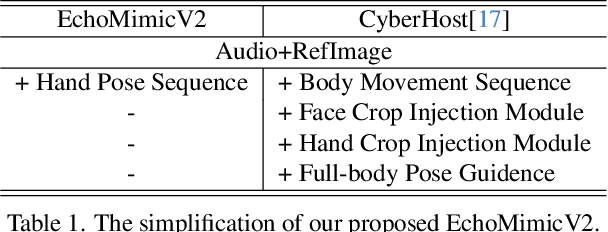
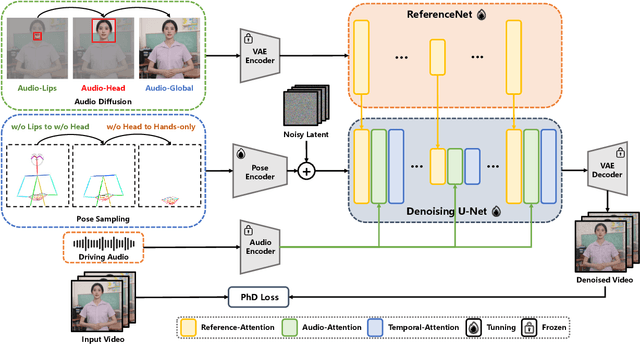
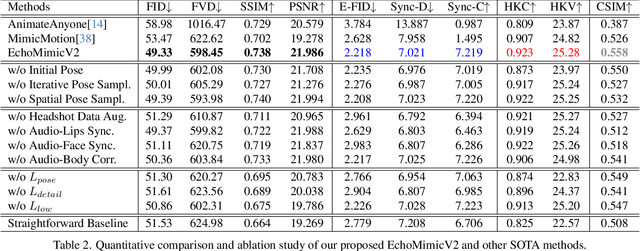

Abstract:Recent work on human animation usually involves audio, pose, or movement maps conditions, thereby achieves vivid animation quality. However, these methods often face practical challenges due to extra control conditions, cumbersome condition injection modules, or limitation to head region driving. Hence, we ask if it is possible to achieve striking half-body human animation while simplifying unnecessary conditions. To this end, we propose a half-body human animation method, dubbed EchoMimicV2, that leverages a novel Audio-Pose Dynamic Harmonization strategy, including Pose Sampling and Audio Diffusion, to enhance half-body details, facial and gestural expressiveness, and meanwhile reduce conditions redundancy. To compensate for the scarcity of half-body data, we utilize Head Partial Attention to seamlessly accommodate headshot data into our training framework, which can be omitted during inference, providing a free lunch for animation. Furthermore, we design the Phase-specific Denoising Loss to guide motion, detail, and low-level quality for animation in specific phases, respectively. Besides, we also present a novel benchmark for evaluating the effectiveness of half-body human animation. Extensive experiments and analyses demonstrate that EchoMimicV2 surpasses existing methods in both quantitative and qualitative evaluations.
Token Caching for Diffusion Transformer Acceleration
Sep 27, 2024



Abstract:Diffusion transformers have gained substantial interest in diffusion generative modeling due to their outstanding performance. However, their high computational cost, arising from the quadratic computational complexity of attention mechanisms and multi-step inference, presents a significant bottleneck. To address this challenge, we propose TokenCache, a novel post-training acceleration method that leverages the token-based multi-block architecture of transformers to reduce redundant computations among tokens across inference steps. TokenCache specifically addresses three critical questions in the context of diffusion transformers: (1) which tokens should be pruned to eliminate redundancy, (2) which blocks should be targeted for efficient pruning, and (3) at which time steps caching should be applied to balance speed and quality. In response to these challenges, TokenCache introduces a Cache Predictor that assigns importance scores to tokens, enabling selective pruning without compromising model performance. Furthermore, we propose an adaptive block selection strategy to focus on blocks with minimal impact on the network's output, along with a Two-Phase Round-Robin (TPRR) scheduling policy to optimize caching intervals throughout the denoising process. Experimental results across various models demonstrate that TokenCache achieves an effective trade-off between generation quality and inference speed for diffusion transformers. Our code will be publicly available.
EchoMimic: Lifelike Audio-Driven Portrait Animations through Editable Landmark Conditions
Jul 11, 2024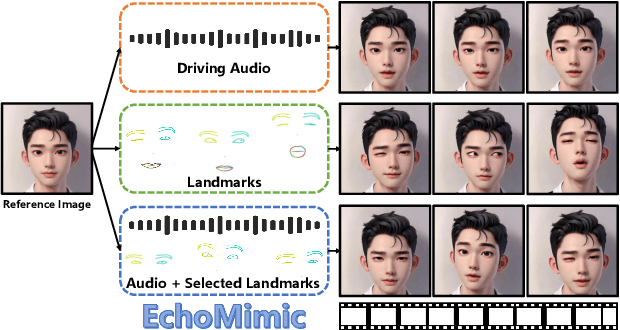
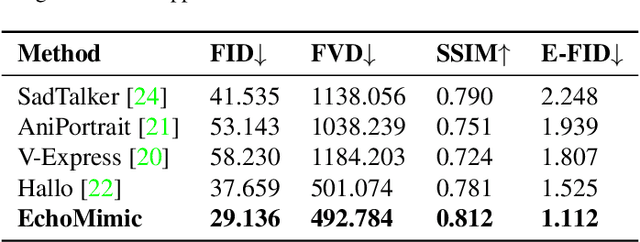
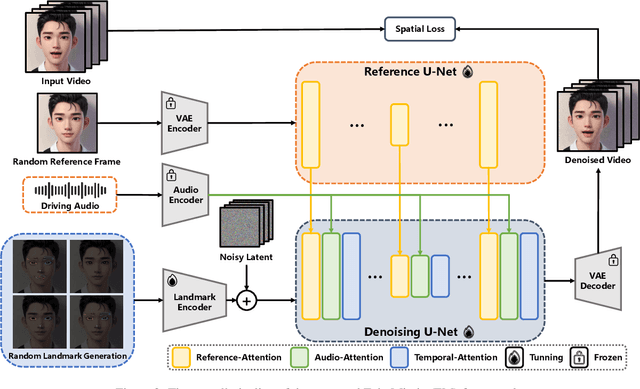

Abstract:The area of portrait image animation, propelled by audio input, has witnessed notable progress in the generation of lifelike and dynamic portraits. Conventional methods are limited to utilizing either audios or facial key points to drive images into videos, while they can yield satisfactory results, certain issues exist. For instance, methods driven solely by audios can be unstable at times due to the relatively weaker audio signal, while methods driven exclusively by facial key points, although more stable in driving, can result in unnatural outcomes due to the excessive control of key point information. In addressing the previously mentioned challenges, in this paper, we introduce a novel approach which we named EchoMimic. EchoMimic is concurrently trained using both audios and facial landmarks. Through the implementation of a novel training strategy, EchoMimic is capable of generating portrait videos not only by audios and facial landmarks individually, but also by a combination of both audios and selected facial landmarks. EchoMimic has been comprehensively compared with alternative algorithms across various public datasets and our collected dataset, showcasing superior performance in both quantitative and qualitative evaluations. Additional visualization and access to the source code can be located on the EchoMimic project page.
 Add to Chrome
Add to Chrome Add to Firefox
Add to Firefox Add to Edge
Add to Edge